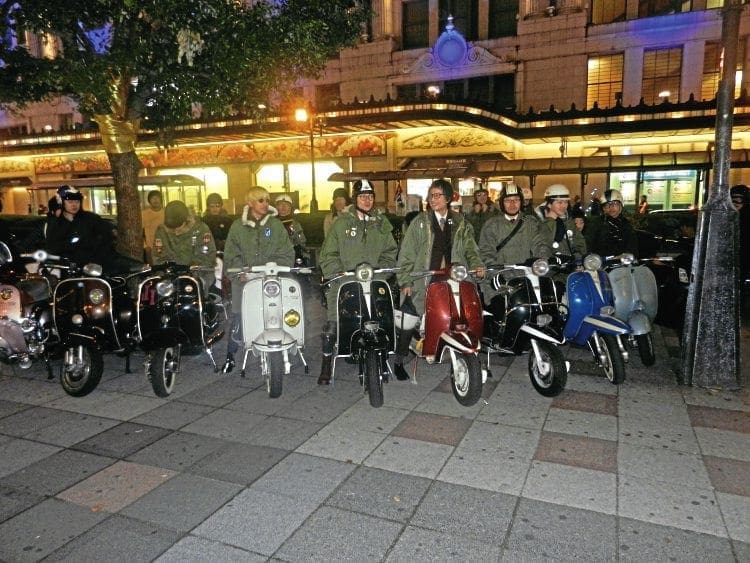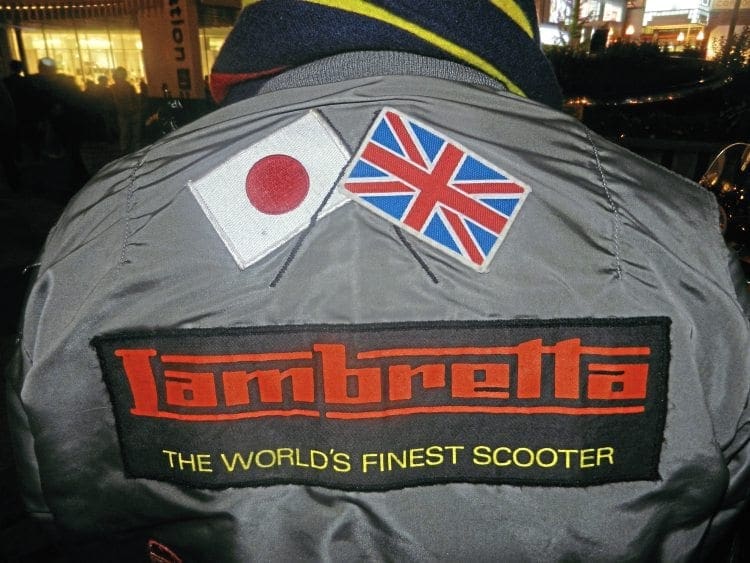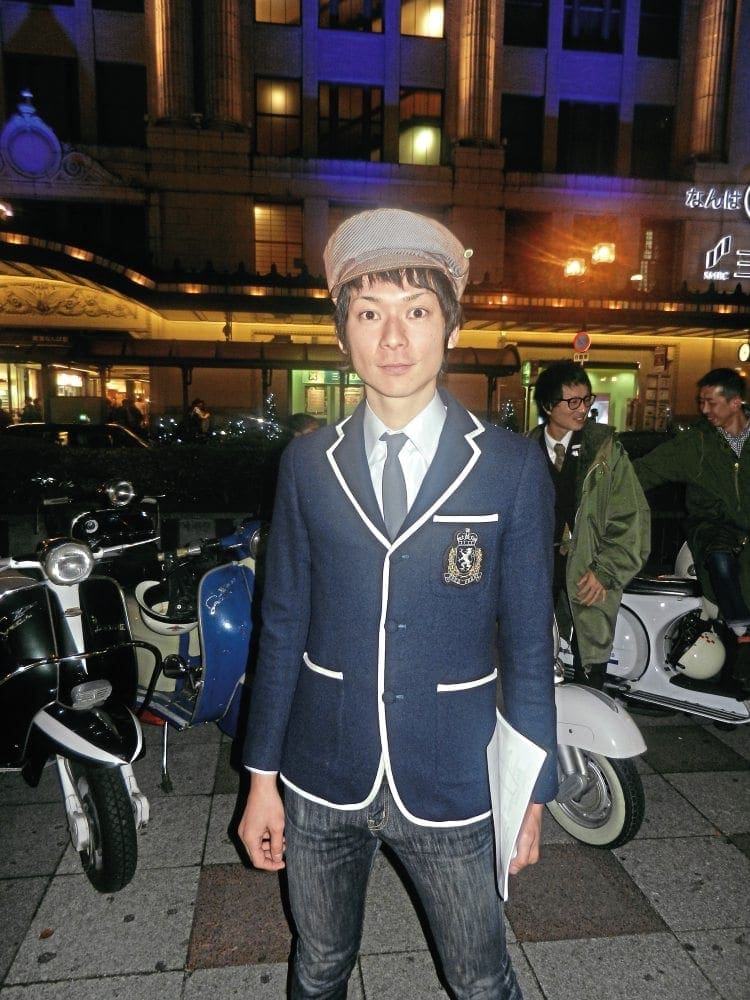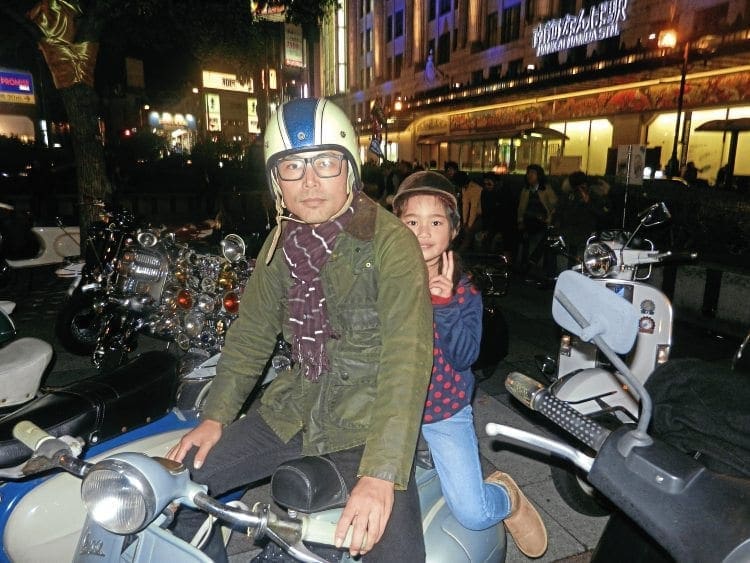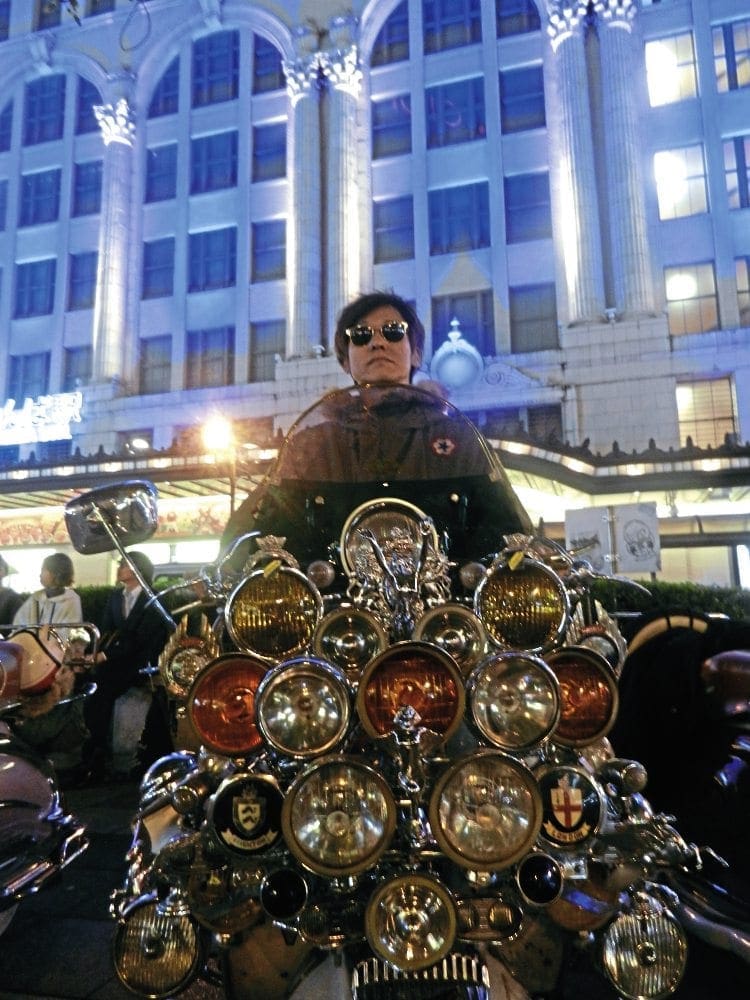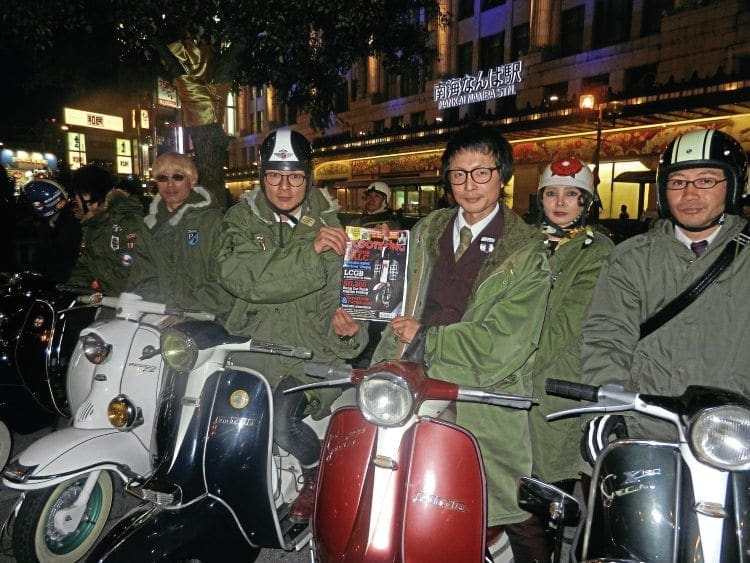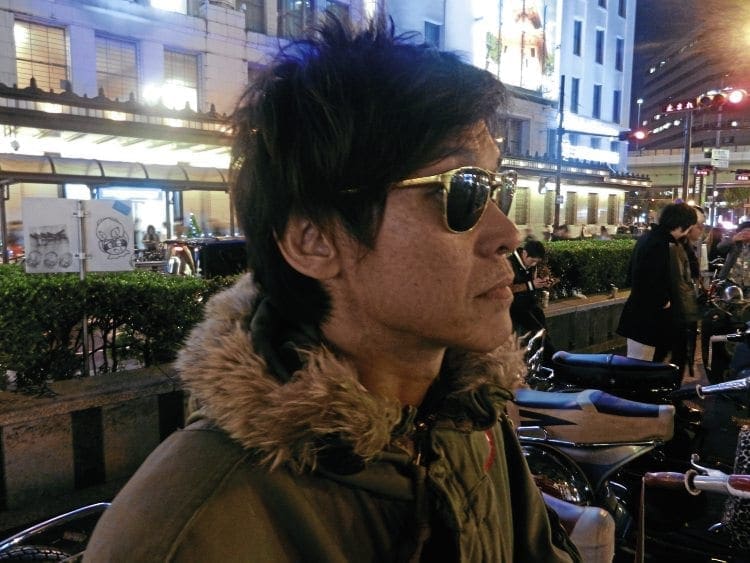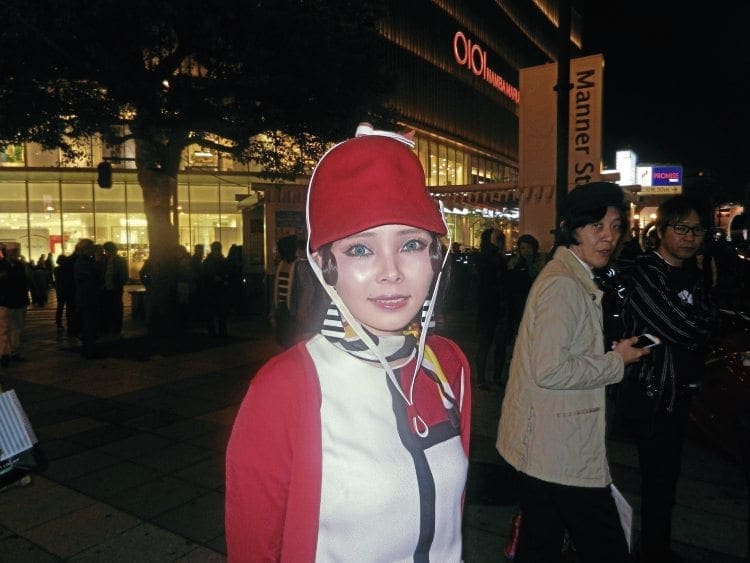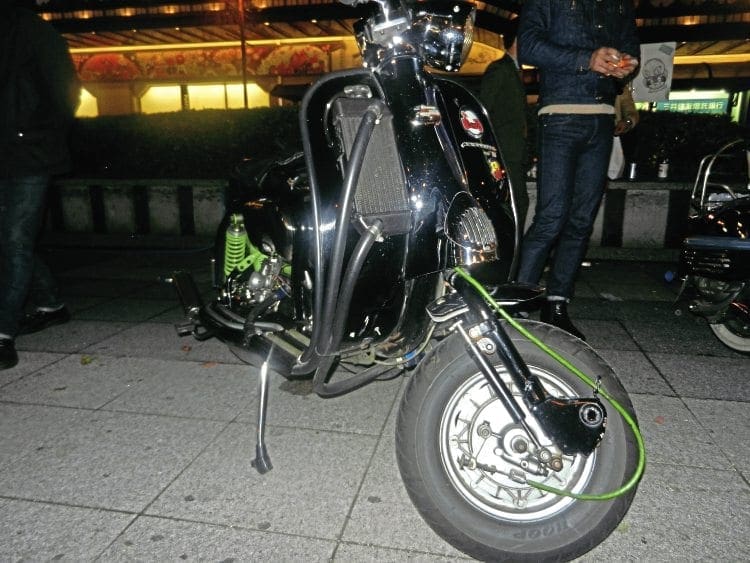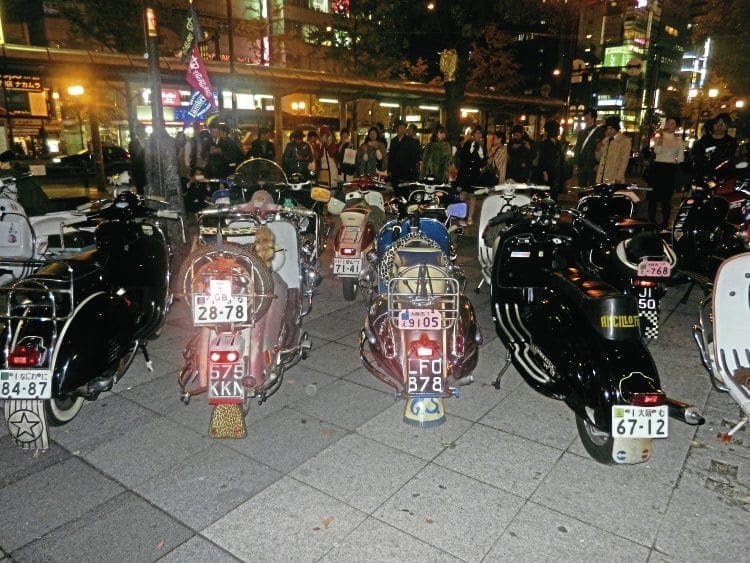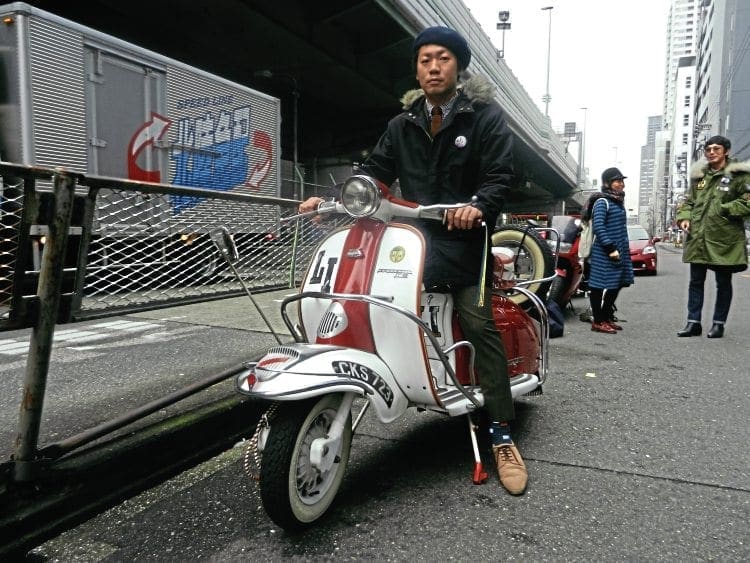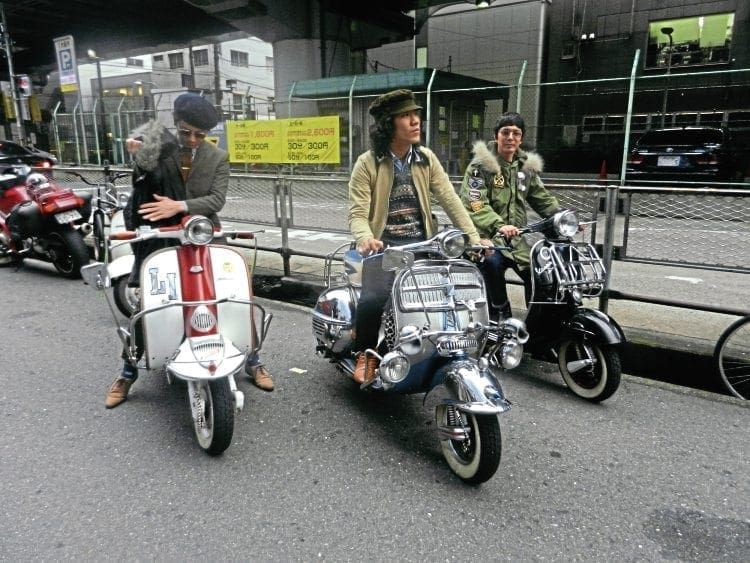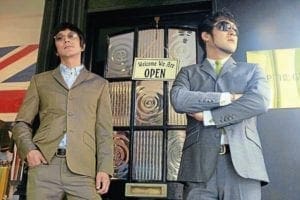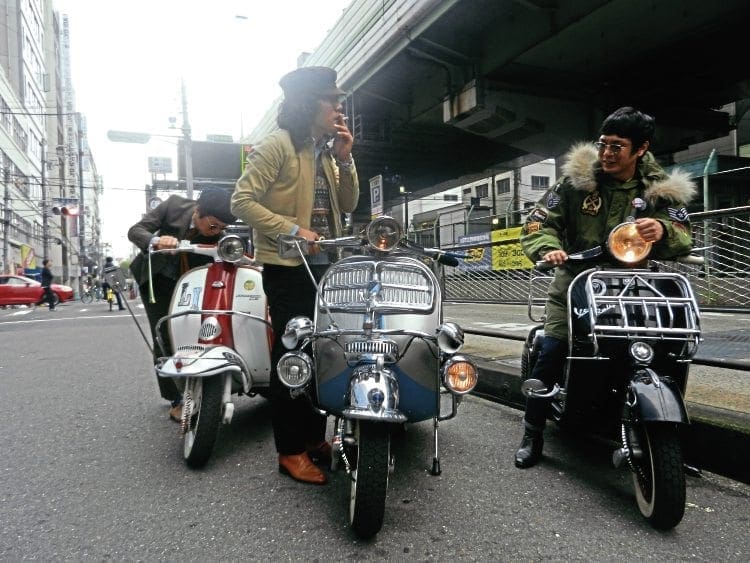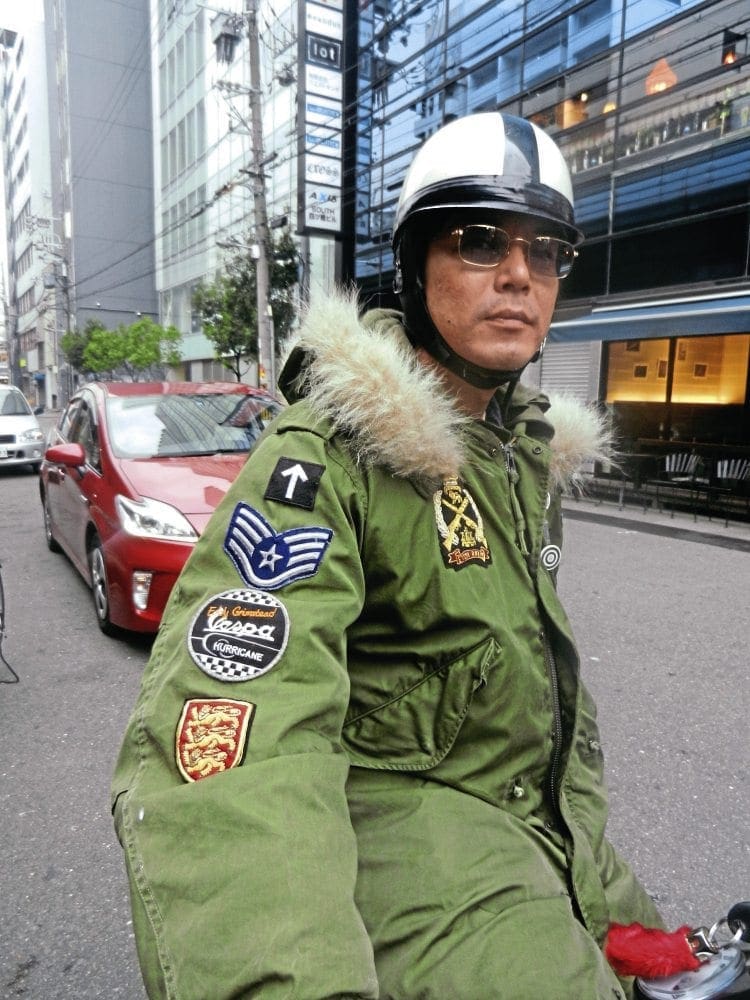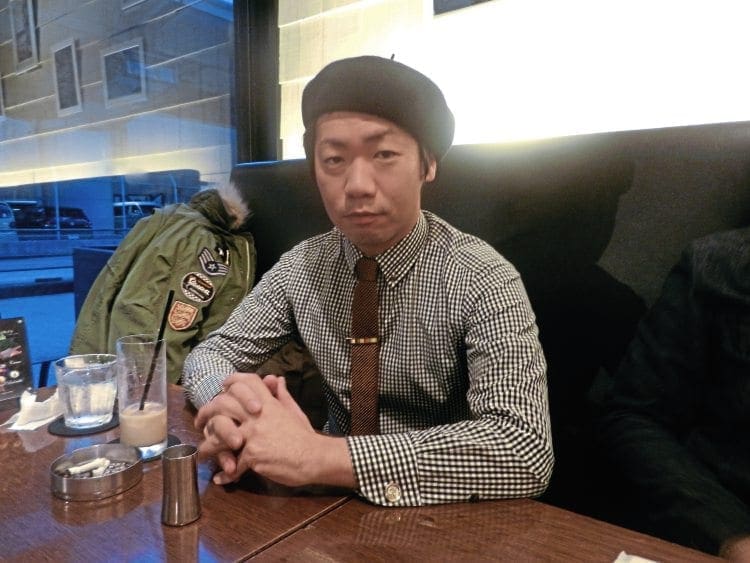Total attention to both metal and clothing were the order of the evening in Japan’s Osaka metropolis last November. Scootering accompanied 18 Vespas and Lambrettas as their well-dressed owners roamed the big city.
Moving north at around 30-40mph is an 18-strong wave of Lambrettas and Vespas – these are the Osaka Mods (and a few scooter boys) riding as a pack, in this, the country’s second metropolis, after Tokyo. The men’s clothing is dominated by M65 and M51 parkas. The accompanying Mod women are immaculately dressed. This is an electrifying blend of the neon lights of the big city, the sound of a column of scooters, and an astonishing attention to British scooter culture and fashion detail.
Before the convoy masses though, Scootering meets Izumi Sawamoto – recognized as the top man of the city’s Mod and scooter scene – along with Yusuke Chikusa, and Takao Jingi, in a café. They ride a Vespa Rally 200, a Lambretta Li150, and a Vespa GS150, respectively. We are 6000 miles away from Britain, and are keen to see how the scene in Japan works. Unlike the UK, there is no smoking ban in Japan, and so the three draw on their cigarettes continuously.
First, of course, we want a few details about their scooters. lzumi’s Rally 200 dates from the mid-1970s, he says. He paid one million yen for it four years ago, in today’s prices, just shy of £7000. Yusuke paid around the same for his early 1960s Lambretta. Takao, meanwhile, spent the princely sum of one and a half million yen on his 1959 GS150, two years ago. The scooter was, he explained, already customized – and that is exactly what prompted him to buy it. Remarkably, he has the famous Rolls-Royce Spirit of Ecstasy bonnet ornament attached to the front of his scooter.
The Japanese have a keen eye for detail, and design. Sometimes, when stopped at red traffic lights in the city, drivers will lower their windows and say how much they like these vintage scooters, states Izumi. Italian Lambrettas are much preferred in Japan, rather than the Indian versions, which are also available. For someone like Izumi, the Mod clothes, music, and the scooters are all linked into one entire, intertwined culture, he explains.
Moving south
At around 6pm, the four of us ride south, to Namba, the nucleus of the city’s shopping and nightlife area, the plan is for me to shadow the convoy. A few minutes later, we stop at the subterranean nightclub where Izumi DJs – there will be a live music event here later, beginning after the ride-out.
Then, we’re on the way to the rallying point. It is located at the front of a Namba department store. Underneath there is a vast train station complex – the view, as we arrive, has an illusory sensation to it.
Commuters and shoppers criss-cross a square: parked there are scooters, Japanese Mods in blazers, and parkas, and some strikingly-dressed female Mods. Passers-by look on, bemused, intrigued. More scooters arrive. A Lambretta fronted with a dazzling array of lamps, and a metallic bird, draws me to it. The rider is Nao Sumii, who has brought his Lambretta TV2 to Osaka 200 miles from Hiroshima, in the west. He imported the scooter from Scootopia, in the UK, a few years ago.
A few metres away from him are Shin Ueshima, with his daughter Misano, on a Vespa Swan Neck. Takashi Nishimura and his wife Mai are also present, with their Lambretta SX125.
Taxi and departure
With the greetings done, the group complete, and riders reacquainted, engines are started, en masse. Attendance is officially noted before the convoy sets off. This is not to be a random ride. Maps outlining the route are handed out and duly pored over. Then, in small packs, the Vespas and Lambrettas peel away.
The pack heads north, riding along a multi-lane road through the Yotsubashi area. On roads like these, vigilance is important on a two-wheeled machine: Japanese truck and car drivers, 95% of the time, tend to manoeuvre, and then indicate as they do so. Often, they don’t bother to indicate at all.
Inevitably, as stops are made at red lights, and the traffic flow changes, we are split into smaller groups. Plus, a Vespa breaks down. But, like anywhere else, Japanese scooterist bonds are strong. Other riders stop to help. Tools are employed and roadside repairs undertaken. Then, the skyscrapers of the city’s business district come into view. Riders at the front of the disjointed group wait for others to catch up. Reunited, we then head south, through the dazzling lights of the Shinsaibashi district, which is dominated by a wide one-way road, lined with large department stores.
Moving further south, we approach the Namba district again. A second lap of the route then starts. The distinctive sound of a wall of Lambretta and Vespa exhausts fills the streets. Two thirds of the way round, I pull alongside Izumi’s Vespa Rally 200, and salute both him and his girlfriend, riding pillion. Job done. I peel away and strike east, away from the neon lights, to a small country town 20 miles outside Osaka.
THE NUTS AND THE BOLTS
In the early 1990s, says Izumi, large numbers of Vespas and Lambrettas were brought into Japan. Asked their views on Indian Lambrettas – as expected, given the Japanese love of detail and heritage – they instantly said no. Italian only. Many parts, like the scooters, were brought into Japan in the early 1990s. Today, Japanese scooter dealers import parts from Germany and Vietnam. Dyno centres are widespread across the country – no problem getting a scooter tuned. In the Japanese scooter world as a whole, Vespas outnumber Lambrettas.
The Japanese ‘shaken’ is the equivalent of the UK’s MoT test. For a 400cc motorcycle – mechanics are often paid to strip down a machine, prepare them for test, and deal with all the paperwork – is in the region of £200-£300, depending on the necessary work. Machines under 250cc, though, are exempt. Scooters riders like Izumi pay an annual insurance of just 10,000 yen, in today’s money the equivalent of about £70.
JUMP THE GUN: THE JAPANESE LOVE OF MOD
Brighton-based 60s menswear shop Jump the Gun went intercontinental in 2014, when it opened a branch in Nara, a town 20 miles east of Osaka. It is owned by Jonathan LeRoy, and his brother Adam, who live in the UK, and Nami Matsui, Jonathan’s wife, who also owns the Brighton Tea Shop, a business above the shop. Jump the Gun, Nara, though, is managed by a charismatic Japanese Mod who goes by the name of Tommy Les Cappuccino. It took three months to prepare the shop, before business could begin, he says. At the start, a container was shipped from the UK, complete with a British front door, the shop’s counter, a scooter, and other items.
Today, it is an oasis of British Mod clothing and memorabilia in Japan — a tastefully appointed clothing emporium, with a luxurious feel. Tommy, who plays guitar in his Mod/jazz hand Les Cappuccino says: “Mod culture is about music and fashion coming together. Mod is a very British idea, and the Japanese love British culture.”
A Japanese Les Cappuccino fan gave him a kimono, with the Mod roundel on its collar (pictured above centre). The garment sums it all up: a Japanese kimono tastefully enriched by that token Mod motif.
OSAKA AND RIDING IN JAPAN
The Vespa Club in Osaka numbers around 50 members. A separate club, known as the Solows, which also consists of 50 members, exists in the larger Kansai area (the region of which Osaka is a part). Members of both clubs are present at the Osaka ride out. The name Solows curiously, was coined from the Japanese word ‘sourou’ meaning, literally, ‘premature ejaculation’. The idea being, they ride fast. Take that as you will. The Solows are led by Nakata.
Hiroshima and Tokyo are the other Japanese cities with sizeable scooter groups. There are subtle musical differences. Some groups are interested in the Mod revival side of things, others are into Northern Soul. Osaka has a population of 2.7 million, and is the nucleus of the wider Kansai region, which has a population of 20 million and, in its own right, an economy which rivals, or is bigger than, some developed countries. Known as the ‘Manchester of the East’, it is, like its English namesake, known for its industrial roots, and down-to-earthiness. Traffic is continuous and often fast-paced, and riders need to be alert.
Additionally, many non-Vespa/Lambretta scooter riders, i.e. those on cheaper, smaller plastic scooters, ride irresponsibly. If hit by a smaller vehicle in Japan, blame is automatically apportioned to the larger vehicle. So, if you are riding your 200cc Lambretta, and are struck by a kid on a 50cc scooter, it’s your fault.
Riders here always need to have their awareness radars switched on when on the road. Cities are linked by toll motorways — there is no fee exemption for scooters or motorcycles; two-wheeled machines must have a capacity of at least 150cc to use them. It is advisable to avoid such routes, and use B-roads, or country routes. Even on a large capacity motorcycle, it’s a hairy, adrenalin-rushing experience using Japanese toll roads, with aggressive, speeding trucks, and a significant number of truck and car drivers illegally using mobile phones. In towns and cities, red light running is common.
Words and Photographs: Tim Maughan
Translation: Saori Okada. With thanks to Dan Mullins.

